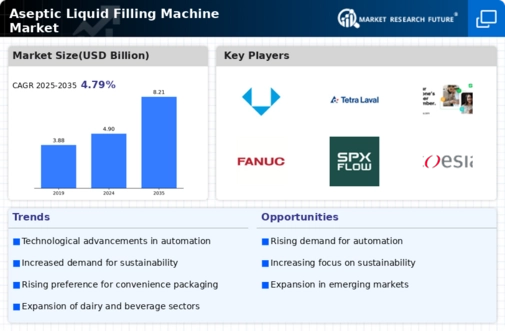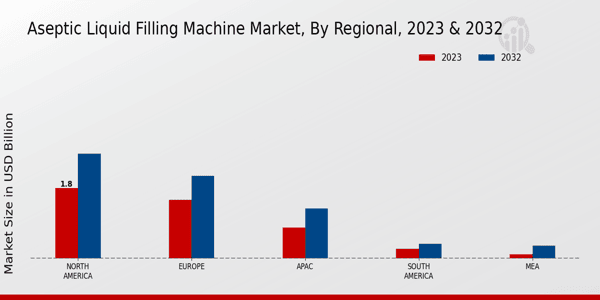Market Growth Projections
The Global Aseptic Liquid Filling Machine Market Industry is projected to experience substantial growth, with estimates indicating a market value of 4.9 USD Billion in 2024 and a potential increase to 8.21 USD Billion by 2035. This growth trajectory suggests a compound annual growth rate of 4.8% from 2025 to 2035. Such projections highlight the increasing adoption of aseptic technologies across various sectors, driven by factors such as rising consumer demand for safe and high-quality products, technological advancements, and regulatory compliance. The market's expansion reflects a broader trend towards improved food safety and sustainability in packaging solutions.
Expansion of the Beverage Industry
The expansion of the beverage industry, particularly in emerging markets, serves as a catalyst for the Global Aseptic Liquid Filling Machine Market Industry. As consumer preferences shift towards ready-to-drink beverages, manufacturers are increasingly investing in aseptic filling technologies to meet the rising demand. This trend is evident in regions such as Asia-Pacific, where rapid urbanization and changing lifestyles drive beverage consumption. The ability of aseptic filling machines to maintain product quality without refrigeration is particularly appealing in these markets, where distribution challenges exist. Consequently, this sector is expected to witness a compound annual growth rate of 4.8% from 2025 to 2035.
Rising Demand for Sterile Packaging
The increasing demand for sterile packaging solutions in the food and beverage sector drives the Global Aseptic Liquid Filling Machine Market Industry. As consumers become more health-conscious, manufacturers are compelled to adopt aseptic packaging techniques to ensure product safety and extend shelf life. For instance, the global market for aseptic packaging is projected to reach 4.9 USD Billion in 2024, reflecting a growing preference for products that maintain quality without preservatives. This trend is particularly evident in dairy and juice segments, where aseptic filling machines play a crucial role in maintaining product integrity and safety.
Sustainability and Eco-Friendly Practices
The growing emphasis on sustainability and eco-friendly practices is reshaping the Global Aseptic Liquid Filling Machine Market Industry. Consumers are increasingly favoring products that are packaged sustainably, prompting manufacturers to adopt aseptic filling technologies that minimize environmental impact. This shift is evident in the beverage sector, where companies are exploring biodegradable and recyclable packaging options. By integrating aseptic filling machines that utilize less energy and reduce waste, manufacturers can align with consumer preferences while also meeting regulatory requirements. This trend not only enhances brand loyalty but also positions companies favorably in a competitive market.
Technological Advancements in Filling Machines
Technological innovations in aseptic liquid filling machines significantly contribute to the growth of the Global Aseptic Liquid Filling Machine Market Industry. The integration of automation and smart technologies enhances efficiency, reduces human error, and improves production rates. For example, advanced filling machines equipped with real-time monitoring systems allow manufacturers to optimize their processes and ensure compliance with stringent quality standards. As a result, these innovations not only streamline operations but also reduce operational costs, making aseptic filling solutions more attractive to producers. The anticipated growth trajectory indicates a market value of 8.21 USD Billion by 2035.
Regulatory Compliance and Food Safety Standards
Stringent regulatory compliance and food safety standards significantly influence the Global Aseptic Liquid Filling Machine Market Industry. Governments worldwide are implementing rigorous guidelines to ensure food safety, compelling manufacturers to adopt aseptic technologies. Compliance with these regulations not only protects consumers but also enhances brand reputation. For instance, the Food and Drug Administration (FDA) in the United States mandates strict adherence to safety protocols, which drives the adoption of aseptic filling solutions. As a result, manufacturers are increasingly investing in advanced aseptic technologies to meet these standards, thereby fostering market growth.








